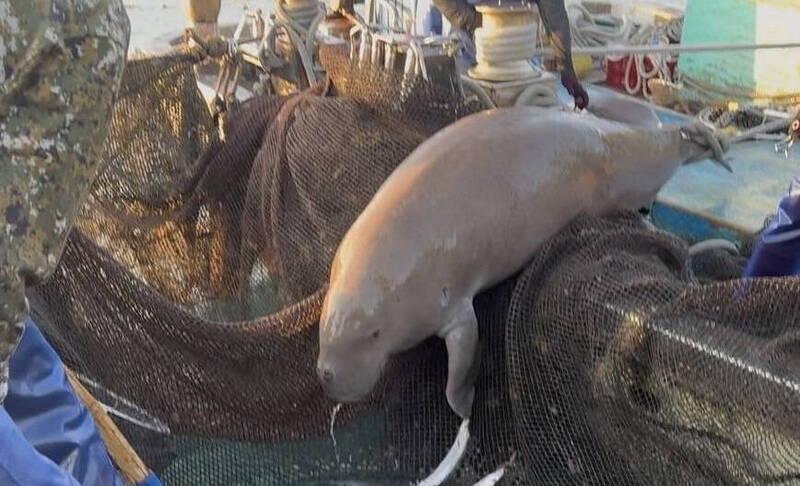A wild live dugong was found in Taiwan for the first time in 88 years, after it was accidentally caught by a fisher’s net on Tuesday in Yilan County’s Fenniaolin (粉鳥林).
This is the first sighting of the species in Taiwan since 1937, having already been considered “extinct” in the country and considered as “vulnerable” by the International Union for Conservation of Nature.
A fisher surnamed Chen (陳) went to Fenniaolin to collect the fish in his netting, but instead caught a 3m long, 500kg dugong.

Photo courtesy of a fisher
The fisher released the animal back into the wild, not realizing it was an endangered species at the time, although he took images and videos of the animal.
The photos have made waves within the public as well as the marine biology community, both in Taiwan and Japan.
“Not just a legend! The beautiful myth reappears in Taiwan,” said Jeng Ming-hsiou (鄭明修), head of Academia Sinica’s biodiversity research center, referencing how dugongs are sometimes considered the origin of mermaid myths.
The most recent record of a dugong in Taiwan were remains found in 1986, later sent to a museum for preservation, Jeng said.
He said he had personally traveled to Japan to study the animals, but only briefly caught a glimpse of them, adding that Japanese researchers tracking dugongs would be very interested in this finding.
In modern Taiwanese history, there has been no record of live dugongs caught in the wild, Taiwan Cetacean Society secretary-general Tseng Cheng-tsung (曾鉦琮) said.
Finding one in Yilan is unexpected, Tseng said, adding that it may have originated in Okinawa and followed ocean currents and food to Taiwan.
Dugongs are related to manatees, although they differ in their tail structure, Tseng added.
They feed on seagrass and so mainly inhabit shallow waters in Sri Lanka, Southeast Asia and Okinawa, meaning there is limited information on them in Taiwan, he added.
In the past, dugongs were hunted in large numbers for their skin, meat and bones, leading to a sharp decline in their population.
They now face severe issues around marine habitat loss.

US climber Alex Honnold is to attempt to scale Taipei 101 without a rope and harness in a live Netflix special on Jan. 24, the streaming platform announced on Wednesday. Accounting for the time difference, the two-hour broadcast of Honnold’s climb, called Skyscraper Live, is to air on Jan. 23 in the US, Netflix said in a statement. Honnold, 40, was the first person ever to free solo climb the 900m El Capitan rock formation in Yosemite National Park — a feat that was recorded and later made into the 2018 documentary film Free Solo. Netflix previewed Skyscraper Live in October, after videos

Starting on Jan. 1, YouBike riders must have insurance to use the service, and a six-month trial of NT$5 coupons under certain conditions would be implemented to balance bike shortages, a joint statement from transportation departments across Taipei, New Taipei City and Taoyuan announced yesterday. The rental bike system operator said that coupons would be offered to riders to rent bikes from full stations, for riders who take out an electric-assisted bike from a full station, and for riders who return a bike to an empty station. All riders with YouBike accounts are automatically eligible for the program, and each membership account

NUMBERS IMBALANCE: More than 4 million Taiwanese have visited China this year, while only about half a million Chinese have visited here Beijing has yet to respond to Taiwan’s requests for negotiation over matters related to the recovery of cross-strait tourism, the Tourism Administration said yesterday. Taiwan’s tourism authority issued the statement after Chinese-language daily the China Times reported yesterday that the government’s policy of banning group tours to China does not stop Taiwanese from visiting the country. As of October, more than 4.2 million had traveled to China this year, exceeding last year. Beijing estimated the number of Taiwanese tourists in China could reach 4.5 million this year. By contrast, only 500,000 Chinese tourists are expected in Taiwan, the report said. The report

Temperatures are forecast to drop steadily as a continental cold air mass moves across Taiwan, with some areas also likely to see heavy rainfall, the Central Weather Administration (CWA) said. From today through early tomorrow, a cold air mass would keep temperatures low across central and northern Taiwan, and the eastern half of Taiwan proper, with isolated brief showers forecast along Keelung’s north coast, Taipei and New Taipei City’s mountainous areas and eastern Taiwan, it said. Lows of 11°C to 15°C are forecast in central and northern Taiwan, Yilan County, and the outlying Kinmen and Lienchiang (Matsu) counties, and 14°C to 17°C